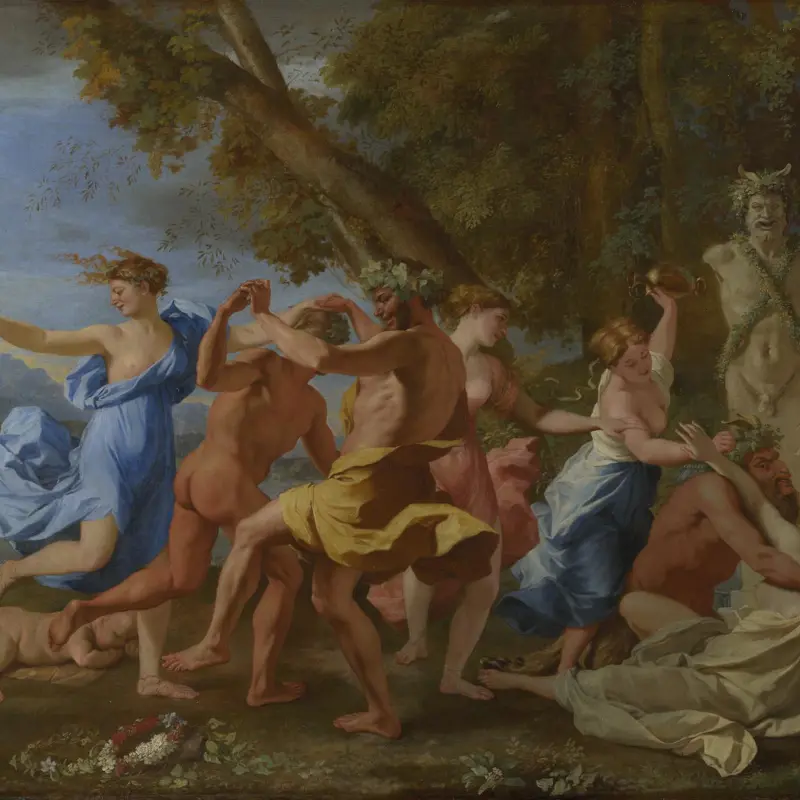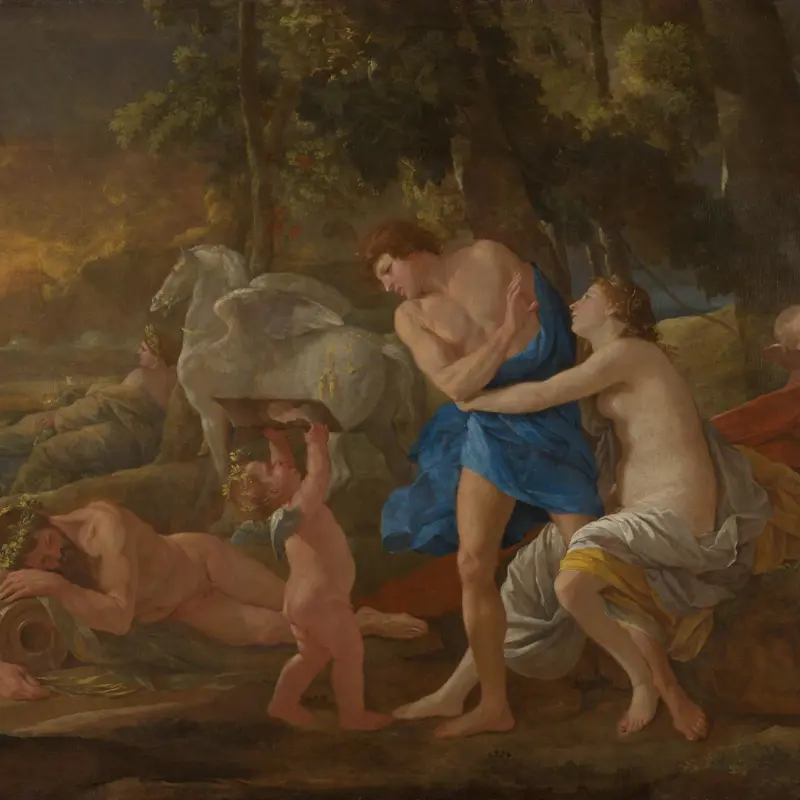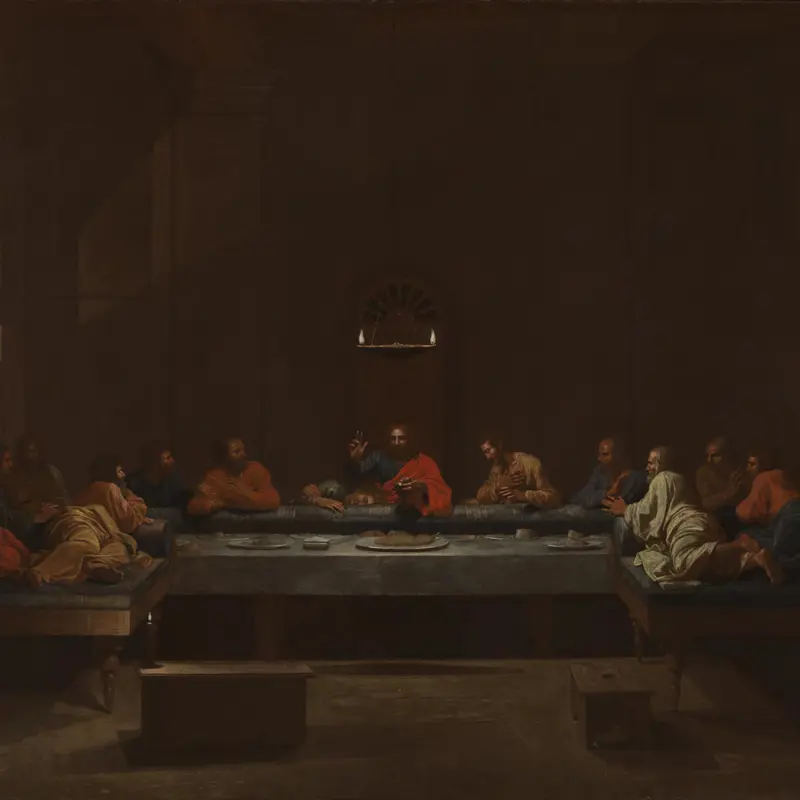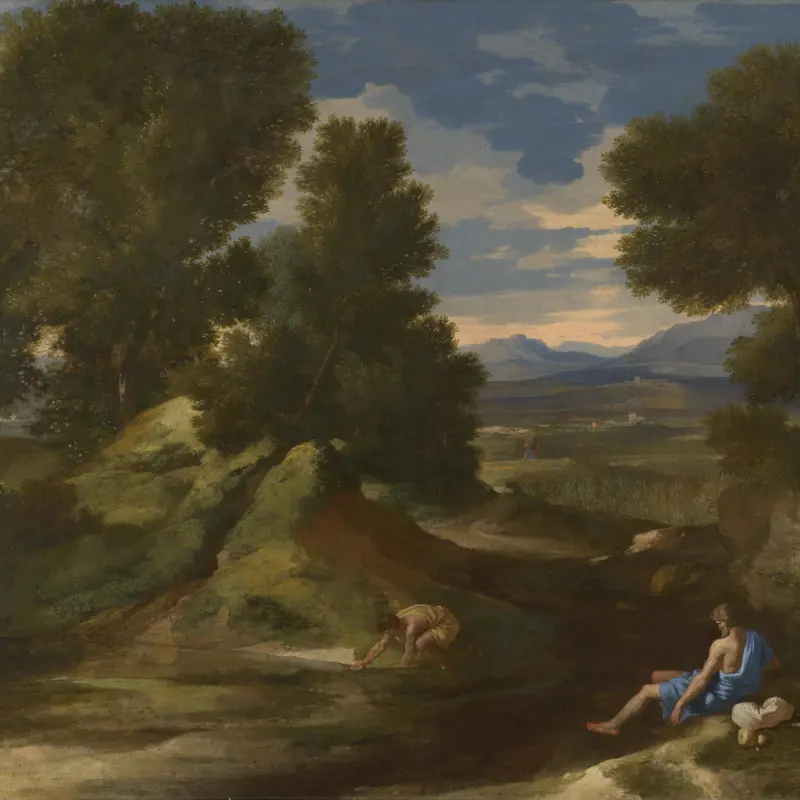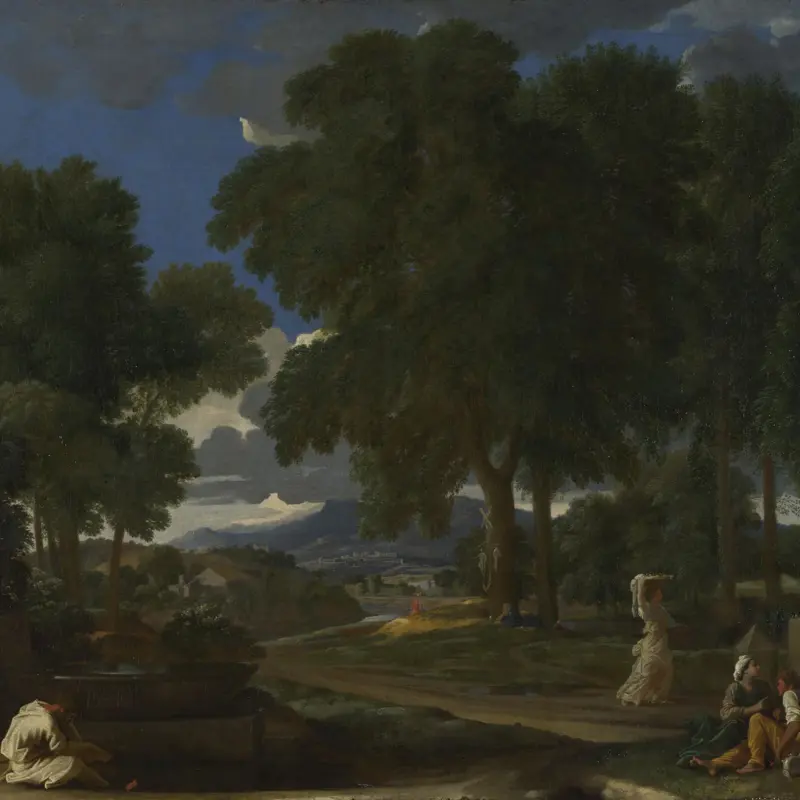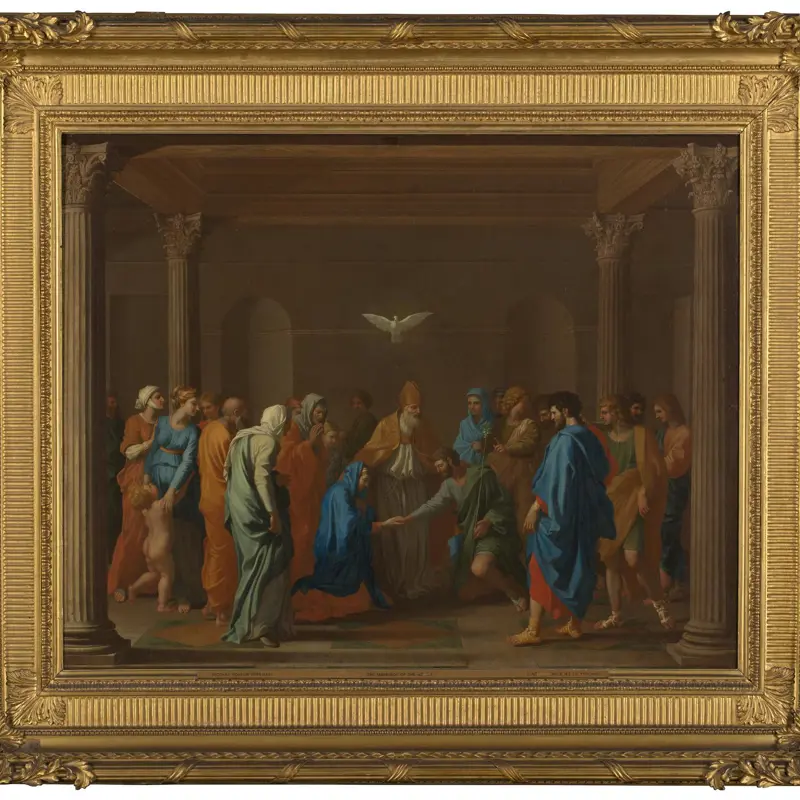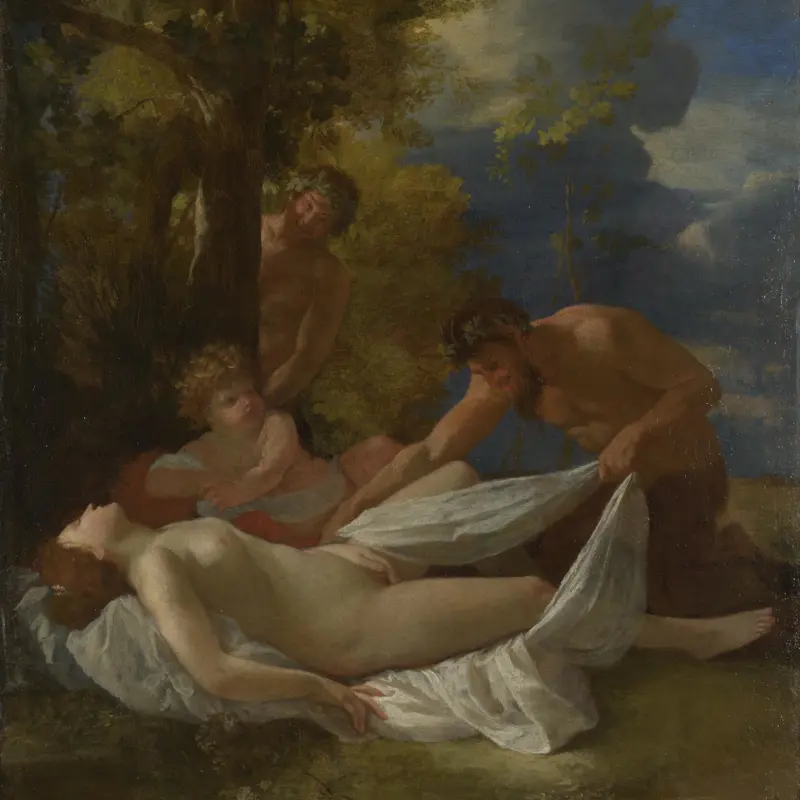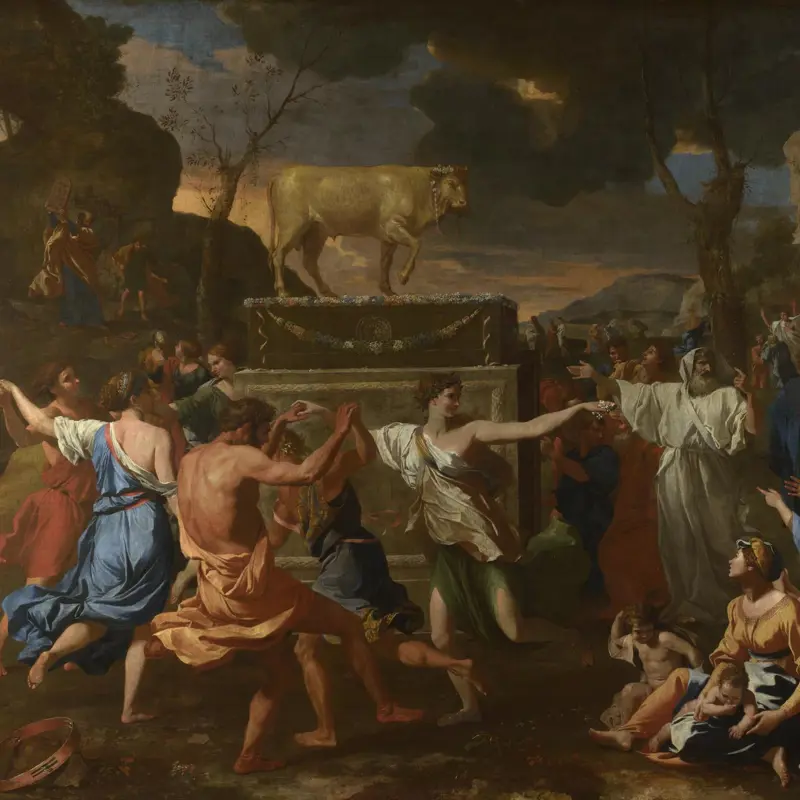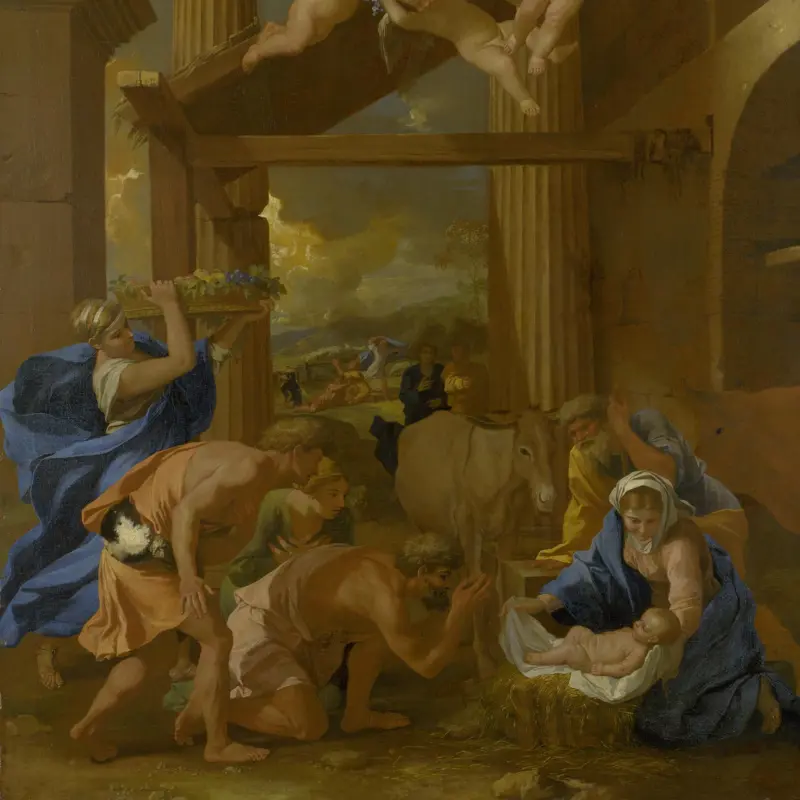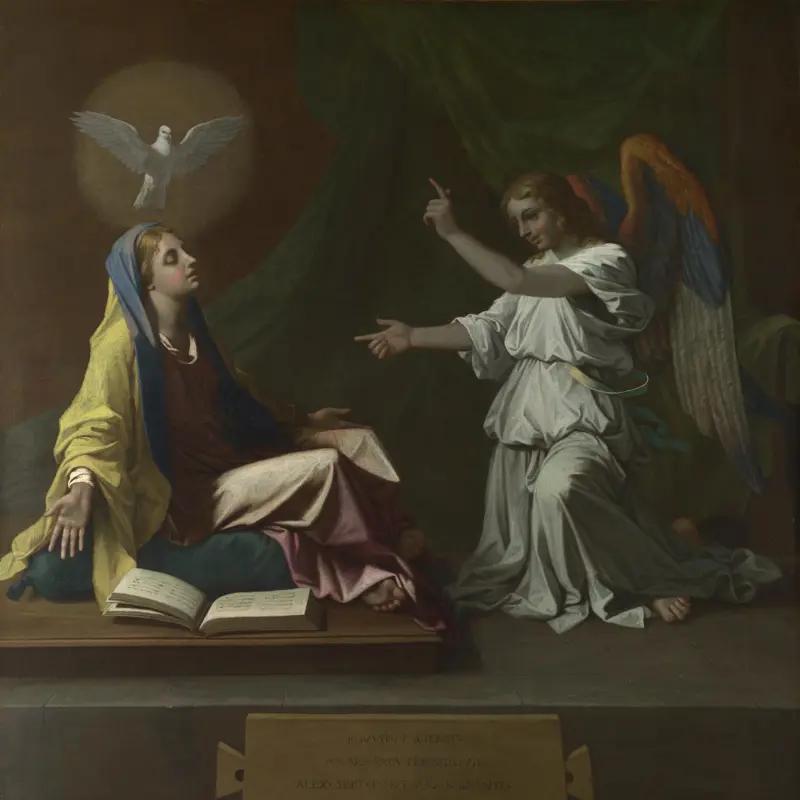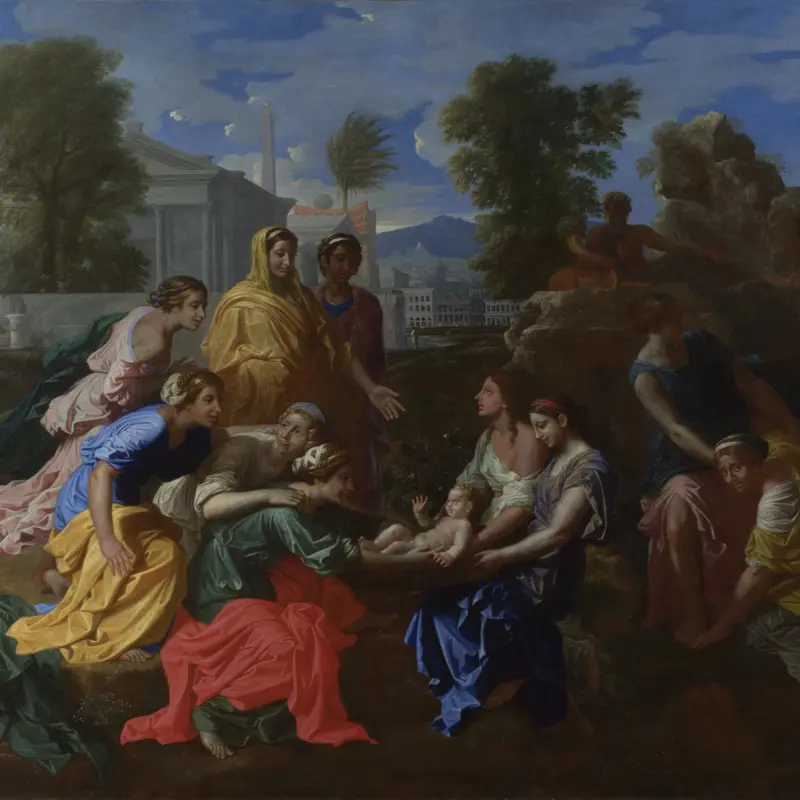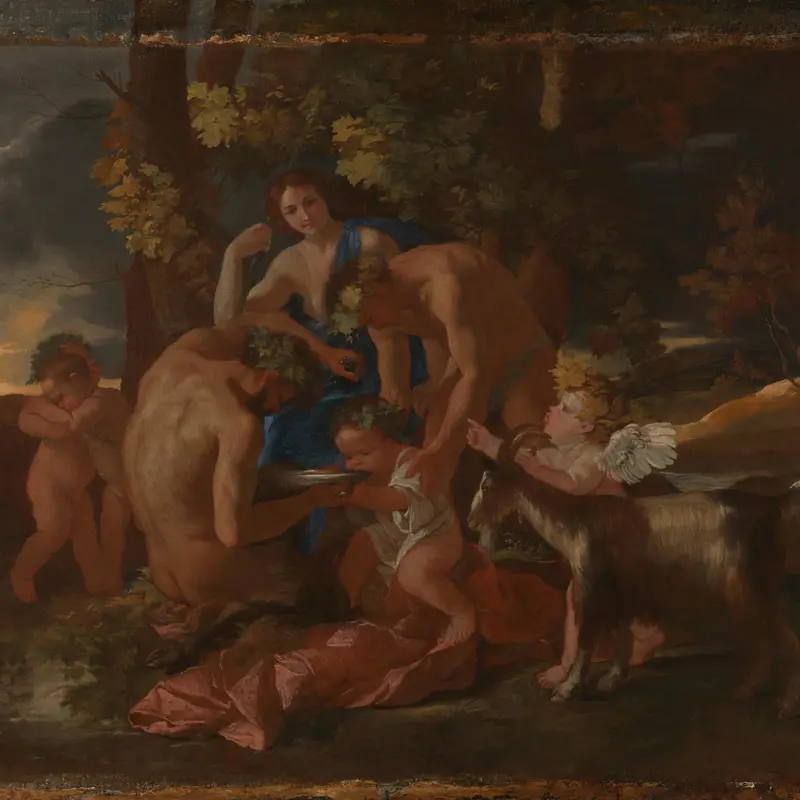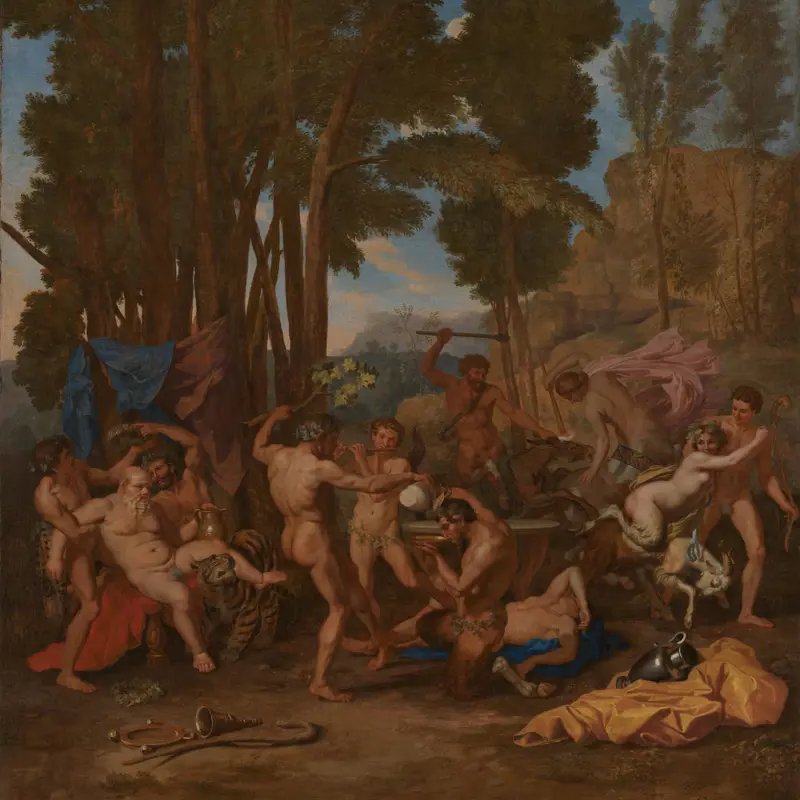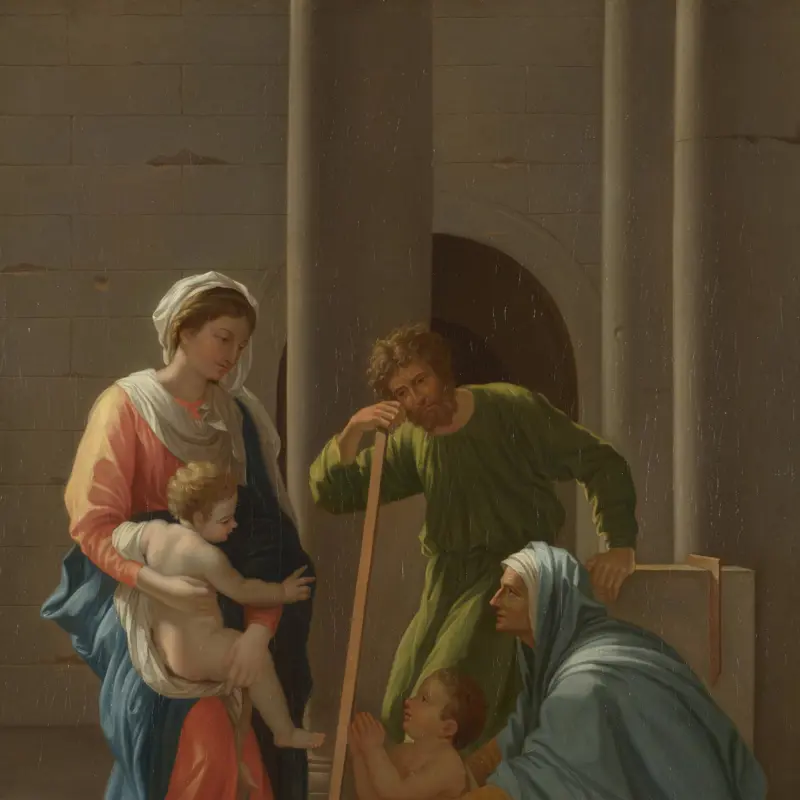Nicolas Poussin, 'Landscape with a Man killed by a Snake', probably 1648
About the work
Overview
A man has been crushed by a snake and lies dead beside a pond: his body is limp and his skin a greenish-grey. We see a man and woman whose gestures and movement show their fear and surprise. The way the landscape is constructed reveals the drama in stages: the running man sees the dead man and the snake, the woman sees only the fleeing man and the fishermen in the distance see only her. Trees are used to frame the action and the zigzag placement of the people in the landscape and the alternating areas of light and shade lead our eye deeper into the distance.
This scene is probably inspired by the notorious snake-infested area of Fondi, south-east of Rome, which Poussin and the painting’s owner, Jean Pointel, may have visited. The subject may be based on an actual event that Poussin heard about or witnessed.
Key facts
Details
- Full title
- Landscape with a Man killed by a Snake
- Artist
- Nicolas Poussin
- Artist dates
- 1594 - 1665
- Date made
- probably 1648
- Medium and support
- oil on canvas
- Dimensions
- 118.2 × 197.8 cm
- Acquisition credit
- Bought, 1947
- Inventory number
- NG5763
- Location
- Room 29
- Collection
- Main Collection
- Frame
- 18th-century French Frame
Provenance
Additional information
Text extracted from the ‘Provenance’ section of the catalogue entry in Humphrey Wine, ‘National Gallery Catalogues: The Seventeenth Century French Paintings’, London 2001; for further information, see the full catalogue entry.
Bibliography
-
1702F. Le Comte, Cabinet des singularitez d'architecture, peinture, sculpture, et graveure, 2nd edn, Brussels 1702
-
1725A. Félibien, Entretiens sur les vies et sur les ouvrages des plus excellens peintres, Trévoux 1725
-
1730A. de Monville, La vie de Pierre Mignard, premier peintre du roy, par M. l'abbé de Monville, avec le poëme de Moliere sur les peintures du Val-de-Grace. et deux dialogues de M. de Fenelon, Paris 1730
-
1829
J. Smith, A Catalogue Raisonné of the Works of the Most Eminent Dutch, Flemish, and French Painters: In Which is Included a Short Biographical Notice of the Artists, with a Copious Description of Their Principal Pictures […], 9 vols, London 1829-1842
-
1914O. Grautoff, Nicolas Poussin: Sein Werk und sein Leben, Munich 1914
-
1939E.K. Waterhouse, 'Nicolas Poussin's Landscape with a Snake', The Burlington Magazine, LXXIV, 1939
-
1944A. Blunt, 'The Heroic and the Ideal Landscape of Nicolas Poussin', Journal of the Warburg and Courtauld Institutes, VII, 1944, pp. 154-68
-
1949F.J.B. Watson, 'A New Poussin for the National Gallery', The Burlington Magazine, XCI/550, 1949, pp. 14-8
-
1952G. de Tervarent, 'Le véritable sujet du paysage au serpent de Poussin à la National Gallery de Londres', Gazette des beaux-arts, II, 1952, pp. 343-50
-
1954F.S. Licht, Die Entwicklung der Landschaft in den werken von Nicolas Poussin, Basel 1954
-
1955The National Gallery, The National Gallery: 1938-1954, London 1955
-
1957Martin Davies, National Gallery Catalogues: French School, 2nd edn (revised), London 1957
-
1960J. Shearman, 'Les dessins de paysages de Poussin', in A. Chastel (ed.), Nicolas Poussin: Actes du Colloque, Paris 1960, vol. 1, pp. 184ff
-
1964C. Dempsey, Nicolas Poussin and the Natural Order, Ann Arbor 1964
-
1966A. Blunt, The Paintings of Nicolas Poussin: A Critical Catalogue, London 1966
-
1967L. Glózer, 'Archemoros oder der Tod des Opheltes. Zu Poussins "Landschaft mit der Schlange"', in Kunstgeschichtliche Studien für Kurt Bauch: Zum 70: Geburtstag von seinen Schülern, Munich 1967, pp. 211-2
-
1969K. Badt, Die Kunst des Nicolas Poussin, Cologne 1969
-
1974W. Stein, Künstler und Werke, Bern 1974
-
1980D. Wild, Nicolas Poussin: Band I, Leben, Werk, Exkurse, Band II, Katalog der Werke, Zürich 1980
-
1982H.D. Russell, Claude Lorrain 1600-1682 (exh. cat. National Gallery of Art, Washington, 17 October 1982 - 2 February 1983), Washington 1982
-
1986R. Démoris, 'L'étrange affaire de l'homme au serpent: Poussin et le paysage', Cahiers de la litterature du XVIIe siècle, 8, 1986, pp. 197-218
-
1990M.R. Lagerlöf, Ideal Landscape: Annibale Carracci, Nicolas Poussin and Claude Lorrain, New Haven 1990
-
1990A. Wintermute, Claude to Corot: The Development of Landscape Painting in France (exh. cat. P. & D. Colnaghi & Co. Ltd., 1 November - 15 December 1990), New York 1990
-
1992A. Grepmair-Müller, Landschaftskompositionen von Nicolas Poussin, Frankfurt am Main 1992
-
1994P. Rosenberg, Nicolas Poussin, 1594-1665: Catalogue raisonné des dessins, Milan 1994
-
1994R. Verdi and P. Rosenberg, Nicolas Poussin, 1594-1665 (exh. cat. Galeries Nationales du Grand Palais, 27 September 1994 - 2 January 1995; Royal Academy of Arts, 19 January - 9 April 1995), Paris 1994
-
1995S. Conrad, 'Félibien's Sources for His Life of Poussin', The Burlington Magazine, CXXXVII/1106, 1995, pp. 321-2
-
1995D. Mahon, 'The Written Sources for Poussin's Landscapes, with Special Reference to His Two Landscapes with Diogenes', The Burlington Magazine, CXXXVII/1104, 1995, pp. 176-82
-
1996E. Cropper and C. Dempsey, Nicholas Poussin: Friendship and the Love of Painting, Princeton 1996
-
1996S. McTighe, Nicolas Poussin's Landscape Allegories, Cambridge 1996
-
1996E. Mai, Das Capriccio als Kunstprinzip: Zur Vorgeschichte der Moderne von Arcimboldo und Callot bis Tiepolo und Goya (exh. cat. Wallraf-Richartz-Museum, 8 December 1996 - 16 February 1997; Kunsthaus, 14 March - 1 June 1997; Kunsthistorisches, 29 June - 21 September 1997), Milan 1996
-
1998H. Keazor, Poussins Parerga. Quellen, Entwicklung und Bedeutung der Kleinkompositionen in den Gemiilden Nicolas Poussins, Regensburg 1998
-
1998M. Bull, 'Poussin and Nonnos', The Burlington Magazine, CXL/1148, 1998, pp. 724-38
-
1999L. Marin, Sublime Poussin, trans. C. Porter, Stanford 1999
-
1999C. Stefani, 'Poussin, Lorrain, Dughet e Salvator Rosa: Ricezione e fortuna del paesaggio classico tra Sette e Ottocento', Studi di storia dell'arte, X, 1999, pp. 201-30
-
1999N. Saint, 'Pour l'amour d'un plaisir sévère: Following Louis Marin', in M. Heusser et al. (eds), Text and Visuality: Word and Image Interactions, Amsterdam 1999, vol. 3, pp. 65-75
-
2001
C. Baker and T. Henry, The National Gallery: Complete Illustrated Catalogue, London 2001
-
2001H. Wine, National Gallery Catalogues: The Seventeenth Century French Paintings, London 2001
-
2003C. Pace, 'Collecting French Seventeenth-Century Paintings for the Nation', Art History, XXVI/2, 2003, pp. 281-315
-
2004S. Barker, 'Poussin, Plague, and Early Medicine', Art Bulletin, LXXXVI/4, 2004, pp. 659-89
-
2006T.J. Clark, The Sight of Death: An Experiment in Art Writing, New Haven 2006
-
2006P. Manoury, 'Poussin philosophe', Dix-huitième siècle, 38, 2006, pp. 611-27
-
2007P. Rosenberg and K. Christiansen, Poussin and Nature: Arcadian Visions (exh. cat. Museo de Bellas Artes de Bilbao, 8 October 2007 - 13 January 2008; Metropolitan Museum of Art, 12 February - 11 May 2008), Bilbao 2007
-
2008W. Sauerländer, 'Paysages de Poussin: Les limites de l'interprétation iconologique', Studiolo, 6, 2008, pp. 191-232
Frame
This eighteenth-century French carved and gilded frame is designed in the late Louis XIV style. Crafted from oak wood, the frame has a pinewood back edge featuring carved dentils. The top of the frame is adorned with a plain, half-round rail, leading to cartouches decorated with shell-and-palmette motifs. Between these cartouches, C-scrolls with palmettes are positioned, facing both inwards and outwards. Following the sanded flat is a sight edge embellished with French acanthus leaves. The current gilding is a second layer, probably applied during alterations to the frame, which has obscured the engraved lines originally made by the ‘répareur’.
Nicolas Poussin himself did not favour such elaborate French period frames; he preferred simple, matt-gilded mouldings.
About this record
If you know more about this work or have spotted an error, please contact us. Please note that exhibition histories are listed from 2009 onwards. Bibliographies may not be complete; more comprehensive information is available in the National Gallery Library.

